1.Introduction
Chinese painting art has its own cultural character and inner spiritual quality. The imagery and ideas contained in the traditional ink language have opened up a broad space for the creation of artistic conception and emotional expression in the paintings. Chinese classical aesthetics has created a unique formal language in Chinese ink painting, which has influenced both China and foreign countries. For example, Bada Shanren, one of the four monks from the early Qing Dynasty, used a lot of traditional Chinese ink painting techniques in his artistic creations, endowing his works with profound spirituality and expressiveness. The article will start with the exploration of ink art, combined with an analysis of Bada Shanren’s ink works, to discuss the specific embodiment of his use of the Chinese ink language in emotional expression.
2.Overview of Ink Language
2.1.Definition of Ink Language
Ink is the fundamental linguistic element of traditional Chinese art, with water and ink being its basic artistic language [1]. Ink painting is an art form through which Chinese painters express emotions, elucidate thoughts, and convey their inner nature.
Particularly, literati ink painting employs unique forms of expressive language, pursuing an artistic realm that is elegant, seclusion, and “plain and innocent.” It advocates for relaxed brushwork, seeking to capture the spirit rather than the form and aiming to express genuine emotions from the heart. The essence of ink painting lies in the expression of one’s aspirations through ink.
2.2.The Beginning and Development of Ink Painting Language
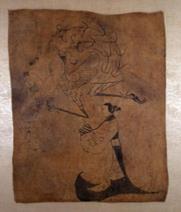
Figure 1: Silk Painting of a Lady, Phoenix and Dragon.
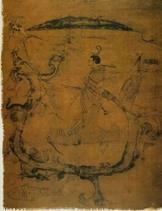
Figure 2: Silk painting depicting a man riding a dragon.
The development of Chinese ink painting has a history of more than one thousand years, and it has profound aesthetic connotation and cultural connotation. Chinese ink painting took its basic shape as early as the Warring States period. The unearthed works from the Chu tombs in Changsha, such as “Silk Painting of a Lady, Phoenix and Dragon” (Figure 1) and “silk painting depicting a man riding a dragon” (Figure 2), primarily utilized outlines with slight ink rendering, showcasing the artistic level of early Chinese painting. During the Wei, Jin, Southern and Northern Dynasties, ink art already had a certain expressive power of monochrome. In the Tang Dynasty, the language of ink and wash gradually flourished. The fundamental reason for the rise of ink painting is not the evolution from color to ink, but the rediscovery and transcendence of ink art by literati painters in the Jin and Tang periods. Wang Wei in the Tang Dynasty perfected the techniques of ink painting, creating varying shades of gray by adjusting the density of water and ink. This eventually formed the trend of ink landscape painting in the middle of the Tang Dynasty. The Song Dynasty was the heyday of ink painting. The royal family set up the Imperial Hanlin Academy of Painting, which promoted the rapid development of ink painting. During the Yuan, Ming and Qing dynasties, Chinese ink painting has been further developed, showing different styles and artistic tendencies, and a large number of outstanding ink painters have emerged. Up to this point, ink painting has occupied the absolute mainstream of the Chinese painting world [2].
3.Analysis of the Style of Ink Painting Language
Traditional Chinese art creation encompasses a diverse range of styles achieved through the skillful utilization of ink and wash techniques. The selection of specific ink painting techniques depends on the subject matter and artistic style pursued in the artwork. Chinese painting creators possess unique preferences and habits when it comes to employing ink and wash techniques, resulting in distinct variations in their execution. The choice of ink types and the quantity of ink utilized are outcomes of creators’ long-term experiences in the artistic process. The application of ink painting techniques in Chinese painting has formed a comprehensive system, where some artists prefer creating with bold and thick ink, while others lean towards a more subtle and mild ink style. A notable example is Huang Binhong, for his landscapes characterized by “black, dense, thick” brushwork [3].
The above elements have prompted each ink artist to form their own artistic style, and ink techniques have also changed with the change of painting style. When a painter or calligrapher uses the tone of the brush and the proportion of ink color, it determines the style and rhythm of the work. Water, the medium of brush and ink, if we use it properly, will give the picture a vivid effect.
4.Emotional Expression of Ink Painting Language
4.1.The Influence of Paper and Brushwork on Ink Effects
Chinese ink art is influenced by the properties of paper and the strength of brushwork, which significantly contribute to the ink effects achieved in the artwork.
The diffusion effect of ink in Chinese ink art is greatly influenced by the type of paper used. Xuan paper, in particular, plays a crucial role in determining the artistic presentation. Xuan paper can be categorized into three types: raw Xuan, mature Xuan, and semi-mature Xuan. Raw Xuan paper, with its soft texture and strong permeability, allows for the artistic effect of “ink separating into five colors” and is suitable for freehand ink painting. Mature Xuan paper, coated evenly with alum water, has a harder texture and higher water resistance, making it suitable for meticulous painting techniques where ink marks are less likely to spread. Semi-mature Xuan paper possesses characteristics that fall between raw Xuan and mature Xuan, providing a balanced ink diffusion property.
In the process of creating ink paintings, the strength of brush strokes, known as pen force, is a key factor determining the ink art effect. Pen force refers to the friction between the brush and the paper, producing different effects such as depth, dryness, and wetness. Artists aim to achieve a state of “flat, stay, round, heavy, and change” during brushwork. By effectively controlling brushwork, artists create intricate and dynamic brushstrokes with variations in intensity, wetness, and weight [4].
4.2.Symbolic Language Facilitates Emotional Expression
Art is a symbolic form of human emotions, a non-logical and non-abstract symbol with the function of expressing emotions. In artistic creation, when the emotion reaches a certain level, the painter may appear a kind of unconscious and crazy creative phenomenon, such as crazy, indiscriminate between things and self, and involuntary [5]. Ink wash artists use the combination of ink and water to create symbols that can extract the true emotions of human beings, that is, images. The imagery in Chinese ink art is a combination of poetry and painting, images such as dead wood and old crows are the embodiment of the bleak state. Zhao Mengfu, a master of calligraphy and painting in the Yuan Dynasty, put forward the famous saying “calligraphy and painting are originally the same” regarding the expression methods of calligraphy and painting, emphasizing that calligraphy and ink painting have the same origin, and proposed to use calligraphy brushwork in ink painting. The lines of calligraphy and ink wash both have the function of expressing emotions. Different line changes reflect different emotions. The different variations of lines convey different inner emotions [6]. It can be observed that the techniques of Chinese calligraphy and ink painting are inherently connected. They are both symbolic languages used to express the sentiments and ideals of literati. In addition, literati are particularly fancy in the interest of brush and ink. Su Shi’s work “Wood and Rock” (Figure 3), In terms of the application of brush and ink, his skill is evident. He uses lighter ink to depict the contours and texture of the peculiar rocks, while the faintly visible dwarf bamboo hidden behind the rocks is portrayed with denser ink, creating a contrast of light and dark.
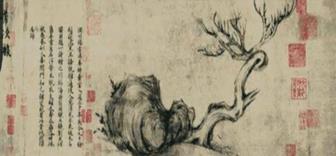
Figure 3: Wood and Rock.
5.Analysis of the Ink and Wash Language in Bada Shanren’s Works
5.1.Introduction of Bada Shanren
Bada Shanren (1626-1705), formerly known as Zhu Da, nicknamed Xuege, Bada Shanren, Ge Shan, etc., was born in the late Ming Dynasty. After the change of dynasty, he escaped into Buddhism. After the change of dynasty, he then entered the Buddhist monastic life. His father and grandfather were both skilled in poetry and painting, and he received a good artistic education from an early age. He excelled in calligraphy, seal engraving, and especially painting. In terms of painting, Bada Shanren is best known for his flower-and-bird paintings. In this genre, he fully inherited the characteristics of previous artists like Xu Wei, embracing a free and expressive style. Combining his unique sense of nostalgia, he conveyed his nonchalant attitude through his art. Bada Shanren boldly broke away from the traditional form of literal representation in his flower-and-bird paintings, incorporating his subjective emotions, imparting sentiment and philosophy into the forms [7]. He anthropomorphized the objects in his paintings, making animals and plants have human emotions, and achieved a high degree of unity in the shape and ink, composition and artistic conception, content and form of his works. Representative works include “Peacock and Peony”, “Lotus and Waterfowl”,etc. In his paintings, details and features of animals such as birds and fish can often be seen. He is also good at putting his emotions on paper when it comes to Buddhist philosophy. In next section, the author will analyze the specific paintings to illustrate the importance of brush and ink language for the painter’s emotional expression.
5.2.Analysis of Works Combining Ink Language
5.2.1.Appreciation of “Lotus and Waterfowl”
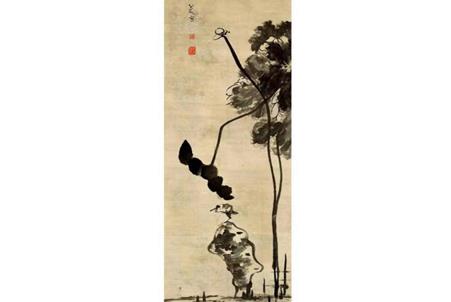
Figure 4: Lotus and Waterfowl.
Lotus and Waterfowl (Figure 4) is one of Zhu Da’s masterpieces. The painting depicts lotus flowers, water birds and strange rocks. The whole painting is full of momentum, and reality and reality coexist. The large blank space on the screen enhances the distant feeling of the work. Bada Shanren used thick black ink to draw smooth and sharp lines, and dotted between the ink colors with light ink diluted with water. He uses dry ink combined with wet brush to create a contrasting relationship. The strong contrast also reflects the entanglement and collision in Bada Shanren’s mind. The lonely bird in the painting looks very lonely, which is the vivid embodiment of Bada Shanren’s loneliness. The weeping lotus in the picture uses spot-dyed brushwork, which also forms a strong contrast with the lone bird dyed in light ink below. At the same time, the huge black lotus hanging over the head of the lone bird also creates a depressing emotional atmosphere. Among them, the black lotus is the portrayal of the author’s emotions towards unsatisfactory things. The strange rocks below are heavy on the top and light on the bottom, and the jumping nature of dot-like brushstrokes creates an unstable feeling. The inscription “Bada Shanren” in the upper left corner of the screen is also very casual. In fact, when signing the signature, he often writes “BaDaShanren” in conjunction with “Xiao and “Crying” [8], which looks like “crying and laughing”, and he also uses such a strong contrast to express his inner feelings. Obviously, the emotional expression in literati ink art is directly related to factors such as the degree of dryness and wetness of the ink, the arrangement of the composition, and the imagery of the picture. Bada Shanren’s frustrated life emotions are fully reflected through ink technique, composition and imagery.
5.2.2.Appreciation of “Song Shu Shuang Lu”
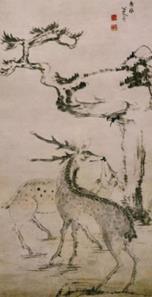
Figure 5: Song Shu Shuang Lu.
“Song Shu Shuang Lu” is a remarkable work created by Bada Shanren during his later years. The painting depicts two sika deer nestled closely together beneath an ancient pine tree. The distant background portrays the pines with a sense of detachment, using powerful yet simple brushstrokes and ink. In contrast, the nearby deer are sketched and colored with light ink and dry brush techniques. The male deer, full of vitality, gazes backward, while the female deer on its back is portrayed with lighter ink and drier brushstrokes, blending harmoniously with the painting’s background. The intimate connection between the deer is vividly captured on the paper, conveying a deep sense of love. The pine trees and sika deer in the artwork emanate a serene and warm temperament, symbolizing the artist’s yearning to detach himself from worldly matters and his nostalgia for the past.
In Bada Shanren’s later works, animal figures with upturned eyes frequently appear. This cartoon-like expression effectively reflects his cynicism and intriguing style, despite the hardships he faced in life. His brushwork skillfully balanced wet and dry techniques, resulting in graceful and natural depictions. Within this simplicity, a hidden sense of nostalgia emanates. Within his works, ink lines are not mere representations of form, but serve as a symbolic language for expressing his inner world. The choice of brushwork techniques, such as the varying thickness and intensity of lines, reveals different emotional states. By skillfully manipulating ink lines, Bada Shanren breathes life into his subjects, capturing their essence and inviting viewers to experience the emotions embedded within them.
Chinese painting has always placed great emphasis on spirituality, artistic conception, communication, “meaning outside the image,” and the significance of form. Bada Shanren serves as a vivid representative of using brush and ink to convey artistic conception and emotion. Each of his paintings exhibits a distinct individuality, whether it be the expressive upturned eyes, the curled-up bird, or the proudly standing lotus. Loneliness, arrogance, and cynicism are subtly embedded in Bada Shanren’s paintings, distinguishing him from other artists. It can be said that Bada Shanren’s artistic style epitomizes the profound connection between ink language and emotional expression. His paintings go beyond the visual representation of subjects, transcending into a realm of spiritual and conceptual significance. Through his brush and ink, Bada Shanren conveys not only his personal experiences and emotions but also universal human sentiments.
6.Conclusion
In conclusion, this study delves into the origins and development of Chinese ink painting, specifically examining the interplay between ink art expression and emotions. By delving into the works of Bada Shanren, a renowned ink artist, the article explores how artists utilize simple artistic media and subjective observation techniques to convey their emotions through the imagery depicted in ink paintings. Emotions become intertwined with landscapes, enabling artists to achieve a profound sense of self-expression. The focus of this article is primarily on Bada Shanren’s ink works, allowing for a detailed exploration of emotional expression in ink art. However, it is worth noting that future research aims to expand the scope by delving into the works of other ink artists who possess a rich emotional repertoire. By gathering additional evidence and insights, this research aims to further substantiate and deepen the understanding of emotional expression in ink art.
Acknowledgement
I am grateful to the teaching assistants who taught me a lot about academic writing skills. Thanks to my parents and classmates who have given me care and support to finish this paper.
References
[1]. Liu Xinhe. The Brush and Ink and Contemporary Nature of Chinese Painting[J]. Public Relations World, 2014, (04): 23-26+22.
[2]. Qiao Hongjun. Research on the style of ink and wash in ancient Chinese flower and bird paintings[J]. Xinmeiyu, 2023, (03): 7-9.
[3]. Han Shaomei. The influence of traditional ink wash techniques on contemporary ink wash techniques [C]. Shandong Normal University, 2015.
[4]. Xu Yahe. The Beauty of Chinese Ink Painting Images[J]. Art Education Research, 2023, (07):17-19.
[5]. Liu Jing. The Contemplative Realm in Bada Shanren’s Flower-and-Bird Paintings[J]. Art Literature, 2022, (10): 16-18.
[6]. Zhou Bingwu. Research on the Aesthetic Features and Cultural Implications of “Line” in Chinese Paintings[J]. Art Appreciation, 2015, (09): 146.
[7]. Ding Yujin. Interpretation of Zhu Da’s Life from “Flower and Bird Paintings” [J]. Art Appreciation, 2023, (03):140-142.
[8]. Liu Yixuan. Interpretation of the Causes of Bada Shanren’s Freehand Flower and Bird Painting Style[J]. Art Appreciation,2022, (29): 141-144.
Cite this article
Zhang,H. (2023). The Emotional Expression of Ink Language in Chinese painting——A Case Study of the Ink Art of Bada Shanren. Communications in Humanities Research,12,117-123.
Data availability
The datasets used and/or analyzed during the current study will be available from the authors upon reasonable request.
Disclaimer/Publisher's Note
The statements, opinions and data contained in all publications are solely those of the individual author(s) and contributor(s) and not of EWA Publishing and/or the editor(s). EWA Publishing and/or the editor(s) disclaim responsibility for any injury to people or property resulting from any ideas, methods, instructions or products referred to in the content.
About volume
Volume title: Proceedings of the International Conference on Global Politics and Socio-Humanities (ICGPSH 2023)
© 2024 by the author(s). Licensee EWA Publishing, Oxford, UK. This article is an open access article distributed under the terms and
conditions of the Creative Commons Attribution (CC BY) license. Authors who
publish this series agree to the following terms:
1. Authors retain copyright and grant the series right of first publication with the work simultaneously licensed under a Creative Commons
Attribution License that allows others to share the work with an acknowledgment of the work's authorship and initial publication in this
series.
2. Authors are able to enter into separate, additional contractual arrangements for the non-exclusive distribution of the series's published
version of the work (e.g., post it to an institutional repository or publish it in a book), with an acknowledgment of its initial
publication in this series.
3. Authors are permitted and encouraged to post their work online (e.g., in institutional repositories or on their website) prior to and
during the submission process, as it can lead to productive exchanges, as well as earlier and greater citation of published work (See
Open access policy for details).
References
[1]. Liu Xinhe. The Brush and Ink and Contemporary Nature of Chinese Painting[J]. Public Relations World, 2014, (04): 23-26+22.
[2]. Qiao Hongjun. Research on the style of ink and wash in ancient Chinese flower and bird paintings[J]. Xinmeiyu, 2023, (03): 7-9.
[3]. Han Shaomei. The influence of traditional ink wash techniques on contemporary ink wash techniques [C]. Shandong Normal University, 2015.
[4]. Xu Yahe. The Beauty of Chinese Ink Painting Images[J]. Art Education Research, 2023, (07):17-19.
[5]. Liu Jing. The Contemplative Realm in Bada Shanren’s Flower-and-Bird Paintings[J]. Art Literature, 2022, (10): 16-18.
[6]. Zhou Bingwu. Research on the Aesthetic Features and Cultural Implications of “Line” in Chinese Paintings[J]. Art Appreciation, 2015, (09): 146.
[7]. Ding Yujin. Interpretation of Zhu Da’s Life from “Flower and Bird Paintings” [J]. Art Appreciation, 2023, (03):140-142.
[8]. Liu Yixuan. Interpretation of the Causes of Bada Shanren’s Freehand Flower and Bird Painting Style[J]. Art Appreciation,2022, (29): 141-144.









